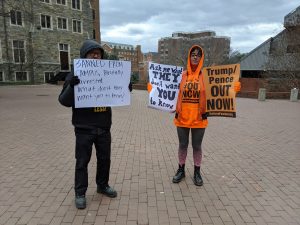Georgetown’s location is a confluence of potential emergencies—with the typical cyber and physical safety concerns of college campuses, the mid-Atlantic’s weather hazards, and the unique security issues of the Washington, D.C. area. Identifying these threats, planning the university’s response, and educating students and staff are overseen by Georgetown’s Office of Emergency Management (OEM).
Working closely with OEM is Georgetown Police Department (GUPD) and Georgetown Emergency Response Medical Service, as well as Washington first responders and issue-specific organizations, such as the National Weather Service (NWS). Together, they aim to prepare the Georgetown community for a wide range of potential crises.
“I like to say that preparedness is a journey. Preparedness is not a destination,” OEM Director Marc Barbiere said. “You never get to the place where you’re fully prepared. You’re constantly preparing, you’re constantly revising, you’re constantly getting ready for something, and it’s very cyclical.”
Georgetown’s emergency threats
Weather threats are a top priority of Georgetown’s emergency preparation and response. The Georgetown area has the potential for hurricanes, thunderstorms, tornadoes, flash flooding, extreme cold, and more, Barbiere detailed.
“Far and away if you look at statistics, if you look at data around loss of life, loss of property, and impact to operations, weather is the biggest one. We have to do more to respond to weather than we do in terms of other threats and other hazards,” Barbiere said.
OEM gets a direct feed from the NWS in order to streamline the student notification process. When NWS issues a D.C. weather warning—for a tornado, severe thunderstorm, or other major event—the alert automatically broadcasts to students and staff through HOYAlert, Georgetown’s emergency notification system.
Despite the large role weather plays, the litany of threats Georgetown prepares for is much longer.
With mass shootings at University of Virginia and Michigan State University in the past year, Barbiere identified violent acts—terrorism and active shooters—as another preparation priority.
The university often assesses their active shooter policy as well as training students and staff, Barbiere said. Over the past decade, Georgetown has engaged in various exercises to practice and evaluate their active shooter response. The latest iteration was a three-day active shooter exercise on campus in June, with Georgetown departments partnering with Metropolitan Police Department, DC Fire, and EMS.
The exercise, simulating everything in an active shooter threat without using live ammunition, is an example of the university’s periodic exercises to “test emergency preparedness and response procedures,” a university spokesperson said. Barbiere noted that, “off the cuff,” the exercise was successful.
OEM also prepares for threats including cyber terrorism on university systems, infectious diseases, and other public health emergencies. They also closely monitor events impacting the D.C. area at large, such as protests and civil disobedience. Tracking these events is particularly important as the area’s transportation infrastructure is easily overwhelmed and difficult to use during periods of high transit, Barbiere said.
Community preparation
For Barbiere, however, planning for physical threats is only part of the preparation process. His biggest concern isn’t one of the emergencies that could happen to the university, but rather the risk of community complacency.
“I think preparing the community is so important because the weakest link in the chain is where you will fail. And if we’re really well prepared, and we’ve got a great office and wonderful equipment and all this great stuff, but the average community member doesn’t know what to do in an emergency? We’ll fail because you’ll fail,” Barbiere said.
To help increase community preparedness, OEM gives presentations to new students and hosts preparedness events on campus. They also train community directors, RAs, and other staff in a variety of emergency procedures, such as how to respond in severe weather or an active shooter threat, Barbiere saide.
“Georgetown began active shooter response training in 2016. More than 100 campus offices and thousands of Georgetown staff, faculty and students have participated. The training focuses on sharing national best practices of ‘Run, Hide, Fight,’” GUPD Chief Katherine Perez wrote in a statement to the Voice.
The university has also been working to provide more opportunities for students to learn “Run, Hide, Fight,” self-defense, CPR, Stop the Bleed protocol, and AED-use, Barbiere said.
However, this training only works if the university has the physical infrastructure to support it. Bleeding control kits have been placed with all AEDs on campus and all classrooms are in the process of being equipped with special locks, Perez wrote.
“Most Main Campus classrooms have been upgraded with intruder deterrent locks. In the case of a shelter-in-place response for an active threat situation, the red button on these door locks can be used to secure you and your class and can only be unlocked from the inside by turning the door handle or with a key issued to GUPD and emergency personnel,” Perez wrote.
Looking ahead & improvement
Some students have criticized Georgetown’s emergency response in recent years. HOYAlert—which Barbiere dubbed as OEM’s “baby”—and Timely Safety Warnings—GUPD’s legally required communications around crimes that may pose an ongoing threat—have been called out for being slow to notify recipients at times.
Sometimes, these criticisms of emergency communications can be explained as disagreements between what university officials deem as necessary alerts, and what students perceive as dangerous.
When a homicide suspect escaped from George Washington University’s hospital on Sept. 6, some students expressed surprise that Georgetown did not issue any alerts, however, a university spokesperson told the Voice there was no information indicating “a specific threat to campus,” so no warning was released. Instead, GUPD increased campus patrols. Barbiere later met with his GWU counterpart, creating a response plan for a hypothetical similar incident at MedStar Georgetown.
Other times, emergency response is not as streamlined or efficient as OEM wants, Barbiere said. He noted that Georgetown’s response is limited by how quickly information is verified, but that they are always working to tighten HOYAlert notification times.
“We can always get better at what we do and that’s part of our job, every time we do something we look at it and say how can we improve? How can we make the next one better because we know, we hear the feedback from students, right? We hear it, we read it, we see it on Flok,” Barbiere said. “We have to take that feedback sometimes and really be reflective and see if we can do better in the future at doing our job.”
But Barbiere said emergency preparedness isn’t going to get any easier, even as they continue to improve internal processes. The consequences of climate change, increased political discord, and the COVID-19 pandemic have changed emergency management at Georgetown, and across the country.
“Who would have thought that, a few years ago, wildfires in Canada would have affected our air quality for days in Washington, D.C. and New York. So, things are changing,” Barbiere said. “What does that force us to do? That forces us, as emergency managers, to think very differently about what we prepare for and what we consider an emergency.”
How students can prepare
Georgetown’s OEM recommends students take the following steps to prepare themselves for emergencies:
- Create personal plans of where you will go and what you will do in case of a threat, for different locations you frequent. Discuss and practice these plans with others, such as roommates and family members.
- Compile a kit of emergency supplies, in case you must shelter in place or evacuate. Check your kit annually and replenish expired and outdated supplies.
- Opt into local government alert systems. Sign up for AlertDC, D.C.’s emergency alert system.
- Ensure that your contact information is updated for Georgetown’s emergency alert system, HOYAlert.
- Download the LiveSafe app. Review the emergency management procedures section which has protocol for what to do in a variety of crises.
- Take basic training courses on what to do in emergencies. Get trained in CPR, First Aid, defibrillator use, bleeding control, etc.
- Reach out to the Office of Emergency Management with questions or for assistance preparing.





